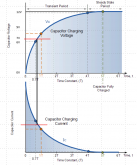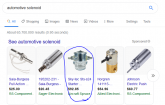The capacitors would only be about 1/2 charged when the Solenoid trips
A solenoid translates electrical energy into physical movement, are you thinking this device would move a switch to an alternative position or are you thinking of a contactor/relay where energising the coil pulls over switch contacts (
...and resets them when de-energised)?
If when you say 'solenoid' you mean contactor, then you can do all the time constant tweaking you want, you're still going to have a permanently enrgised heavy duty coil. You mention the contactor you found having a coil resistance of 3R21 ohms with 6.69V required to energise it, that's a constant 2.08A (
I=V/R = 6.69V / 3.21 ohms = 2.08A) load or 333Wh per day (
P = VI = 6.69V x 2.08A = 13.9W x 24 hours = 333Wh). I did go and have a look for contactors on digikey, the
cheapest 12VDC contactor I could find able to switch 150A or more was £74 + shipping. That one required 9V to energise and had an 11R ohms coil, or 0.818A or 177Wh per day. £74 is not cheap, and neither is 177Wh per day.
Now if when you say 'solenoid' you do actually mean a solenoid (
i.e. an electromagnet used to physically move something), and that solenoid is used to turn a switch, once switched the solenoid can be de-energised - it's done its job. The way I would imagine this solution working would be:
(1) Press and hold a momentary push button until you hear a 'clunk'
(2) The button would connect the pre-charge resister to the inverter
(3) A similar circuit to that above could be used to momentarily energise the solenoid
(4) The solenoid physically rotates the switch, and is then de-energised
(5) The switch connects the battery to the inverter
(6) To isolate the inverter, physically turn the switch back
(7) Wash, rinse and repeat
Possible? Yes. Practical? No. Pragmatic? Definitely not. Just buy a £1 resister, a £15 rotary switch and suffer the 30 seconds inconvenience it takes to pre-charge manually! ;-)
Regards,
David.












